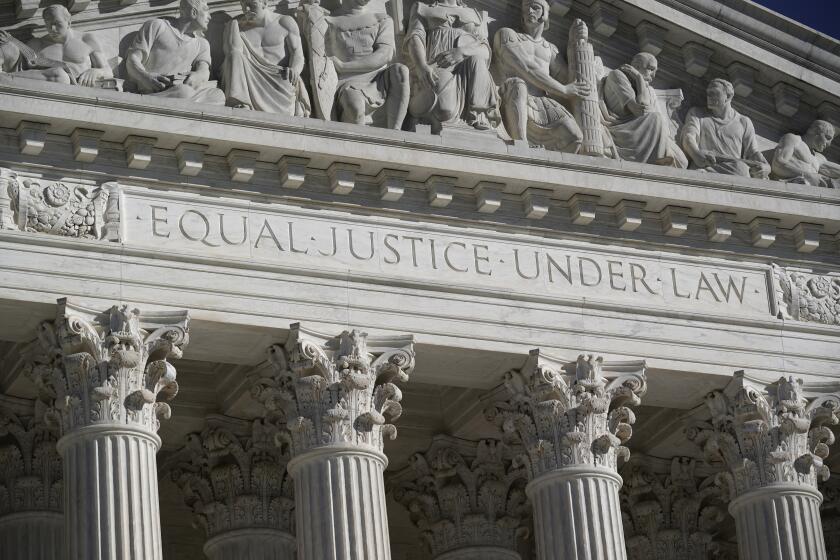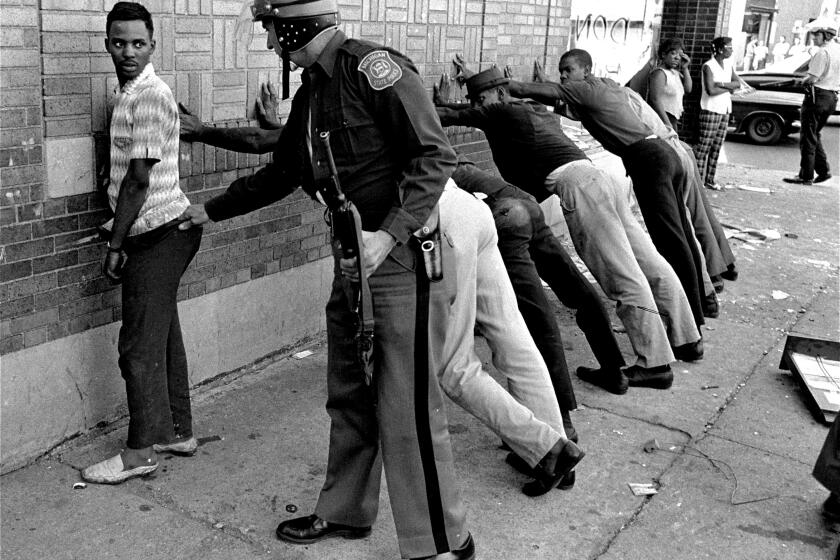The last time America broke apart: How author Kevin Boyle retold the 1960s
- Share via
On the Shelf
The Shattering: America in the 1960s
By Kevin Boyle
W.W. Norton: 480 pages, $32
If you buy books linked on our site, The Times may earn a commission from Bookshop.org, whose fees support independent bookstores.
Kevin Boyle made his name as a writer by vividly reconstructing a dramatic 1920s murder case in “Arc of Justice,” which won a 2004 National Book Award. But he begins “The Shattering,” his new history of the 1960s, with just a photograph. A group stands in front of a modest bungalow. Fathers and sons; mothers and daughters. The men are in shirt-sleeves or aloha shirts, the women in capri pants or summer skirts. American flags fly on all the houses stretching down the block. It looks like a scene from the original “The Wonder Years.”
The nostalgic setup — July 4, 1961, on a “rising middle class” block in Chicago — is deliberate. But “The Shattering,” which intertwines the civil rights movement, the Vietnam War and the sexual revolution, is no saccharine account. Boyle uses the story of Ed and Stella Cahill, the owners of that bungalow, to frame the book, showing readers how much had been gained by people like them — a prosperity built on inequality — and how their world would be shattered by the ‘60s.
We get a quick history of the early 20th century through the Cahills’ eyes. Both lost a parent to the Spanish flu, but Stella’s early life was rougher. Her parents arrived from Poland around 1910. Her father, a tailor, found work in a sweatshop and died when Stella was 2. Money was tight, especially after the Great Depression. When she met Ed in 1938, he was working a New Deal gig as a file clerk. He served in World War II before the couple settled down. By the time of the photo, Ed had risen to head of sales at Vacuum Can; they’d bought the bungalow from his dad, welcomed a third child and purchased a car and a television set. Stella appeared to be “smiling into the sixties,” as Boyle points out.
“What I wanted to do was complicate that sense of ‘50s security and stability,” Boyle said during a phone call from his home in Evanston, Ill., where he is the Mason Professor of American History at Northwestern. “That’s there, but it’s built on lives that were profoundly insecure until then.”
What stability the Cahills had achieved, he added, “was built on some real injustices, on racial exclusion and racial oppression, the power of the military-industrial complex and a very narrow sense of what intimate life should be like. But it was for Stella a remarkable thing, and what the ‘60s does is break it open.”
In “Set the Night on Fire: L.A. in the Sixties,” Mike Davis and Jon Wiener track the uprisings, outrages and elections that shaped the city.
Stepping back from the Cahills, Boyle — who radiates a contagious teacher’s enthusiasm — writes of multiple protest movements that overlapped. His civil rights era is hardly monolithic. “There’s this sensibility that everyone in that movement should have had the same ideas. Why?” Boyle draws on the latest scholarship to describe a multi-front struggle that was national in scope, grappling with housing segregation, urban renewal and police repression as well as Southern voting rights, but ever divided over tactics and strategies.
Perhaps most important of all, the author draws a throughline to the birth of modern conservatism. “This is a period of massive upheaval that gives you Richard Nixon at the end,” Boyle said. “I think it’s really important to be able to contextualize the relationship between these multiple movements and a very powerful, conservative reaction that then starts to reshape … the center of American politics.”
Boyle’s complicated approach to a mythologized era grew directly out of his efforts to teach a class about it. “Students will often think about the 1960s as the classic triumvirate of sex, drugs and rock and roll and I’m trying to say there is something much more profound going on here.” He wanted to reconnect a new generation to a period fast receding from living memory — beginning with a 1961 photo nearly as distant from today as that era was from the 19th century closing of the Western frontier.
But first Boyle had to make it interesting: “You’re trying to hook people.” He fills the book with evocative vignettes, often of lesser-known figures. There’s Norman Morrison, the 30-year-old Quaker activist who set himself on fire outside the office of Secretary of Defense Robert McNamara; Harvey and Johnetta Clark, a young Black couple with two children, driven out of their new apartment in the all-white Chicago suburb of Cicero by mobs; Estelle Griswold, the head of Connecticut Planned Parenthood, who got herself arrested at 61 for distributing birth control devices in defiance of the state’s ban on contraception. She was the Griswold in Griswold v. Connecticut, the Supreme Court precedent that laid the groundwork for Roe v. Wade.
The Biden administration sued Texas and said its abortion law violates pregnant women’s constitutional rights. The Supreme Court delays a decision.
Boyle also excavates some of his own past, a family history not so different from the Cahills’. His parents were Irish immigrants who came to the U.S. in their 20s. His dad, who had been a cop back in Ireland, got a job as a bank teller, eventually working his way up to loan manager. Like the Cahill kids (all three of whom went to college), Boyle and his brother attended parochial schools. He went on to the University of Detroit and to graduate school at the University of Michigan, one of the top history programs in the country.
At 61, he is young enough not to have experienced the ‘60s firsthand but old enough to have been shaped by them — especially the white flight that transformed his neighborhood. “You just can’t have grown up in Detroit in the early ‘70s and not see the enormous burden of race in American society. That’s most shaped my sense of the world and my sense as an historian.”
A rare example of a full-time academic who has managed to attract a popular audience, Boyle attributes his crossover success to his family — to the middle-class monocultural world they grew up in and he wanted to channel. It started when he gave his parents a copy of his first book, an academic study titled “The UAW and the Heyday of American Liberalism, 1945-1968.” They were proud, of course, but on visits he could see the bookmark still stuck in the first chapter. “I wanted a book my dad would read. He was a really big reader, but he just wasn’t going to get through my labor history.”
When he started “Arc of Justice,” about a Black doctor tried in the murder of a member of a white mob surrounding his house, Boyle was determined to write for — and not just about — people like his father and the Cahills. That commitment meant “bringing the stuff I’d already learned how to do in a classroom into the writing.” It also meant learning a few simple tricks, such as using contractions to sound more conversational. The one big thing he did was to send each chapter to his dad, who would reply with notes.
His father died in 2011, before Boyle started work on “The Shattering,” but that imagined audience is still what animates his writing. “It’s so much more important to me that someone who’s not a historian might pick up this book and say, ‘That’s interesting,’” Boyle said. “I’m trying to write for people like my dad.”
Jelani Cobb and Matthew Guariglia’s “Essential Kerner Commission Report” highlights sadly relevant findings on America’s history of systemic racism.
Lewis is the author of “The Shadows of Youth: The Remarkable Journey of the Civil Rights Generation,” among other books.
More to Read
Sign up for our Book Club newsletter
Get the latest news, events and more from the Los Angeles Times Book Club, and help us get L.A. reading and talking.
You may occasionally receive promotional content from the Los Angeles Times.










